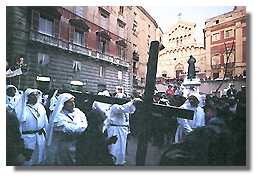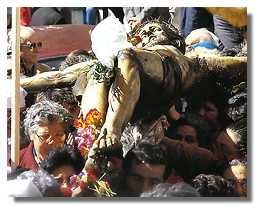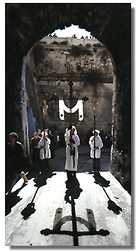
Procession of Mysteries
Lonis's wood statues parade in the Procession of Mysteries (Is Misterius)
on the Friday before Palm Sunday. Announced by a drum roll, the members of the Archconfraternity
del Crocefisso, a religious institution founded in 1616, begin the procession. The
men are dressed in simple calf-length, hooded, white tunics tied with cords at their waists. The veiled women hold candies and rosaries. They wear black dresses
with capes and white sashes. At about 3:00 P.M., the procession leaves Piazza S.Giacomo
to visit the seven churches in Cagliari's historic center (symbolizing the seven
Stations of the Cross) where they are greeted by singers in candid robes. At each stop,
they leave an image representing various moments of the Passion of Christ.

Procession of Cristo Morto (Dead Christ)
On Good Friday, at about 1:00 P.M., the procession of Cristo Morto (Dead Christ) leaves
from Via S.Giovanni. A punctual ritual, heralded again by drum rolls, songs, and
parades of crosses and standards, accompanies the crucifix shaded by a white canopy.
The members of the Archconfraternity del Solitudine, founded in 1608, open the procession.
The men dress in hooded white tunics with the red and blue cross of the Order of
the Trinitari around their necks. The women are dressed rigorously in black.
The highest level members can be recognized by the varitas
(from the Spanish term vara,
meaning switch, the symbol of authority). The cantores
(traditional Sardinian singers) as in similar processions, sing in Italian, having
lost the tradition of singing in the Sardinian language. Preceded by two infant figures
symbolizing Saint John and Mary Magdalen, the statue of Our Lady of Sorrows follows.
With a long and complex ceremony that had lasted from the preceding Monday to Wednesday,
the statue had been clothed in black, its head swathed in white and adorned by a
silver crown, and its chest pierced by the swords of the seven sorrows. The route
follows Viale Regina Elena, Piazza Martiri, Via Mazzini, Via De Candia, Via Canelles and
ends at the Duomo.
The statue of Christ seated on a sedan chair embellished with veils and lace returns
to the Church of S.Giovanni the next day before 5:00 in the afternoon (the brief
ceremony is called su scravamentu
in the Sardinian language). Tradition has it that if the statue is retrieved late,
it will remain permanently in the Cathedral's possession.
|









